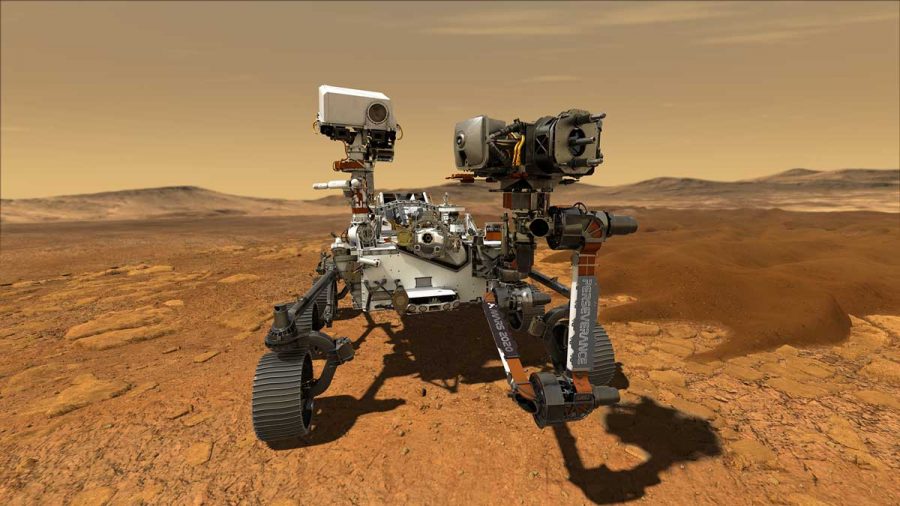What has Perseverance, the latest Mars rover, been up to?
A view at some of Perseverance’s duties while stationed on Mars
March 23, 2021
Almost ten years ago, NASA announced plans for its Curiosity robot, which entail planting it on Mars in an attempt to do things that humans could not. As of today, Curiosity is fully operational on the big red planet. However, a new bot has joined the lonely landscape of planet Mars, and it contains loads of updated technology and science. NASA’s latest project was a complex rover named Perseverance, and it has had a couple of important jobs to complete during its shift on Mars.
Anais Zarifian, Perseverance’s mobility testbed engineer from NASA’s Southern California Jet Propulsion Lab, said in a press release about the recent rover events, “When it comes to wheeled vehicles on other planets, there are few first-time events that measure up in significance to that of the first drive.”
The Mars rover initially had to be tested in various ways before any scouring for alien life was conducted. As NASA’s Perseverance Mars Rover twitter account released on March 3, referring to itself in the first-person point of view, “This week I’ve been doing lots of health checkouts, getting ready to get to work. I’ve checked many tasks off my list, including instrument tests, imaging, and getting my arm moving. Warming up for a marathon of science.” The rover was tested to drive longer distances and to flex its complex robot arm, as well as transfer general data to NASA’s labs.
Despite the fun of driving Perseverance around, the experts at NASA did design the rover for other more specific actions. The importance of the rover’s arm, as stated by the Mars 2020 Perseverance rover deputy mission manager Robert Hogg, is to closely examine the environment on the planet. “That’s the main tool the science team will use to do close-up examination of the geologic features of Jezero Crater,” he said, “and then we’ll drill and sample the ones they find the most interesting.” Advanced cameras will also help with this task, as will the rover’s ability to go mobile across the Martian surface.
The rover is paving the way towards more knowledge of the astrobiology of Mars by collecting a number of samples. An objective for Perseverance is to be the first rover to salvage Martian soil to be examined by scientists who will determine the characteristics of the geology of Mars as well as the history of the planet’s climate. The samples would be extracted from Perseverance in a future mission to Mars. The rover will soon be carrying these samples if all goes well, but for now, it carries a Mars Helicopter named Ingenuity by it’s under-belly.
Ingenuity is simply a technology demonstration, but it would be the first act of aviation controlled by humans on Mars. The Mars Helicopter has some similar features to those of a drone, with skinny limbs and a few overhead blades. Perseverance has already dropped the debris shield, a structure that protected Ingenuity from potential harm when landing. “Away goes the debris shield, and here’s our first look at the helicopter. It’s stowed sideways, folded up and locked in place, so there’s some reverse origami to do before I can set it down. First though, I’ll be off to the designated ‘helipad,’ a couple days’ drive from here,” Perseverance tweeted on March 21st. The flight of Ingenuity would be an iconic moment for not only NASA, but the human race, proving that not only can flight be done here on Earth or on the Moon, but it can be carried out on a planet 156 million miles away.
Additionally, Perseverance has taken over 12,000 pictures to date with its attached high-quality camera equipment. “When you see a beautiful image from Jezero, consider that it took a whole team of Martians to get it to you. Every picture from Perseverance is relayed by either the European Space Agency’s Trace Gas Orbiter, or NASA’s MAVEN, Mars Odyssey, or Mars Reconnaissance Orbiter. They are important partners in our explorations and our discoveries,” stated Justin Maki, chief engineer for imaging and the imaging expert for the Mars 2020 Perseverance rover mission, in the early weeks of March 2021. The images then flow through NASA’s Deep Space Network (DSN) to be posted online for public view upon approval.
Perseverance has many sols, or Martian days, ahead, and has many things to keep itself busy in the near future. From its robotic arm attaining samples of Martian sand to the anticipated deployment and flight of the Ingenuity helicopter, Perseverance has its work cut out for itself. It will be challenging, but the experts at NASA have the science to support the progress they will hopefully continue making through this Mars rover. A circle of excitement surrounds the mission, and reasonably so. Of course, there is always a possibility of discovering extraterrestrial life forms that could have existed on Mars in the past. All of this hope, all of this determination and all of this ingenuity will hopefully enable this rover, and its helicopter side-kick, to persevere on their missions on Mars.






